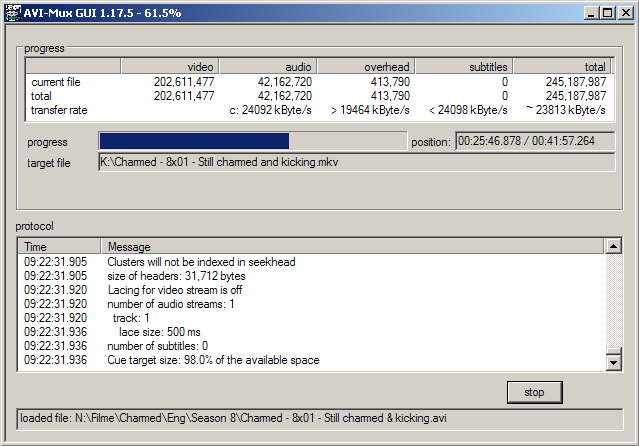| no audio | No audio will be included in the output files. You can demux the video stream using this option |
| all audio | AVI-Mux GUI will mux all audio streams into the output files, regardless which streams have been selected. |
| no subtitles | No subtitles will be written to the output files, regardless of the selection. |
| all subtitles | All subtitles will be written to the output files, regardless of the selection |
| title | For MKV files, this is the segment title, for AVI files, it is the file title. Note that MKV segment titles are stored in UTF-8, meaning that you can type whatever you like (again, except for klingon), whereas AVI only supports ANSI, meaning you should stick to languages using the character set of the language locally installed on your Windows system |
| delay of audio stream | Indicates the delay of the selected audio stream. If you type some delay there, without selecting any audio stream before, that setting will be ignored.
Values greater than 0 delay the stream, Values below 0 remove the beginning of the stream.- AVI - Output
To delay a stream, either Silence-Files are used to pad the beginning, or, if no matching file is found, the first 20 ms (or the first audio frame, whatever is more) is duplicated. In the latter case, the beginning of the audio source should be silent. For values below 0, the beginning of the stream is removed - MKV - Output
Delays are set by creating timestamps accordingly. The stream itself is not modified
If you've extraced a stream using DVD2AVI, the delay should be read automatically from the filename. If it does not work for whatever reason, indicate the delay DVD2AVI reports here. |
| switch to protocol | Display the protocol, which contains information about recent muxing processes. You can leave the protocol view by again right-clicking onto the dialog. |
| save configuration | Saves a skript file which allows to restore the current state of the program, including all settings, all open files, all selected video sources, audio sources and subtitle streams, names and delays of streams. Beginning with v1.17.5, restoring file and stream order is supposed to work correctly. When there are chapters, and additional chapter xml file will be created. The amg file will load this chapter file. |
| immediately add audio sources | When this setting is enabled (which is default), an audio source will be created automatically from each audio file you open. This, of course, does not allow to join several audio files to one audio source. When you disable this setting, no audio source will be created from audio files you load, so that you can join several audio files to one audio source. See joining files. |




